Do you want to know what to expect from 23andMe results if you or your family has origins in Mexico? In this post, learn how Mexican ancestry shows up on 23andMe, and see examples.
Testing with 23andMe is a great way to find out which regions of the world your ancestors likely called home. In addition, we can learn a lot about our family tree through the DNA matches that we will discover in our results.
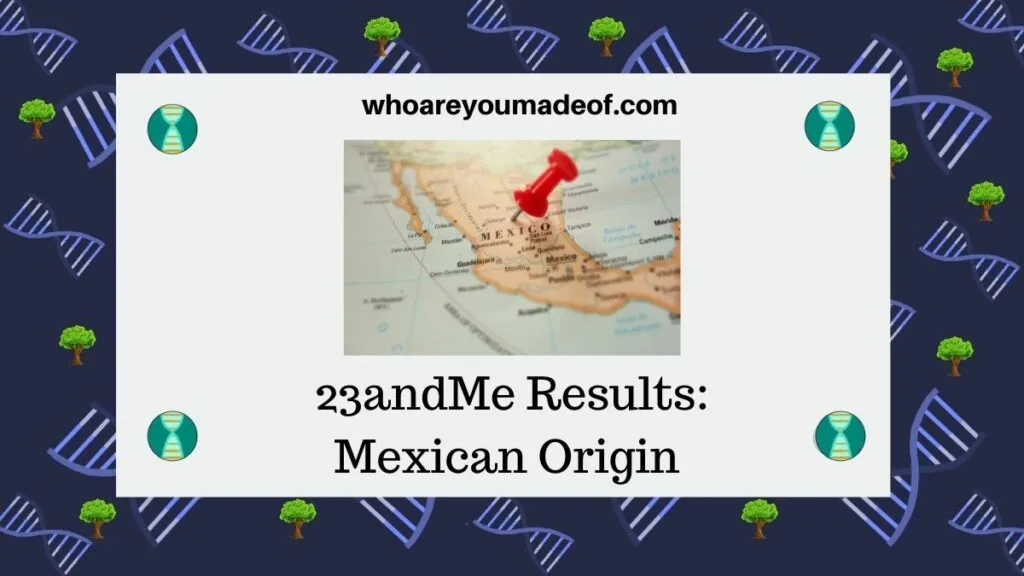
People who have ancestors from Mexico might be surprised to learn that there is really no such thing as "Mexican DNA". Instead, people with Mexican heritage will discover that their ancestors were genetically diverse with roots in indigenous North and South America, Europe, Africa, and Asia.
My family began exploring their roots in Mexico through DNA testing a few years ago. While I personally do not have roots in Mexico, it has been a great pleasure to help my close family members learn more about their Mexican family trees.
Before we get started, I feel like it is important to emphasize once more that Mexico is a country made up of people with very diverse ancestry. This means that the examples that I show below from two people with roots in Mexico might look very different from those belonging to other people.
This is part of what makes Mexico and Mexican culture so beautiful and interesting to explore. The United States has a reputation for being a "melting pot", but Mexico is culturally more diverse.
What does Mexican ancestry show up as on 23andMe?
Individuals with Mexican ancestry will find regions around the world that most closely match their DNA on their 23andMe Ancestry Composition Report., which is similar to an ethnicity estimate. In addition, if you were born in Mexico or have recent ancestors from the country, then your DNA results might display matching to the Recent Ancestry in the Americas.
If your DNA matches countries in the Recent Ancestry in the Americas populations, then the country that matches your DNA will be displayed. You might even be able to see the name of Mexican states that most closely match your DNA.
For example, below you can see that this person's DNA has a strong match to Michoacán, Mexico and nine other regions:
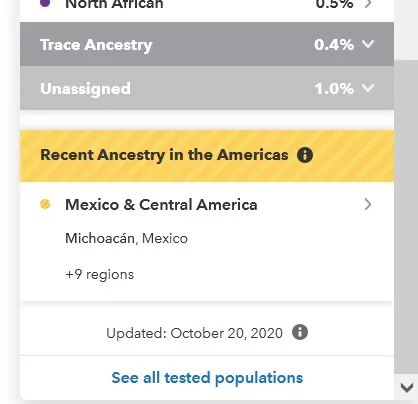
The map below shows the different states that most closely match this person's DNA. Most of their known ancestors going back 3-4 generations are from Morelos, but there are stories in the family about people coming from other parts of Mexico.
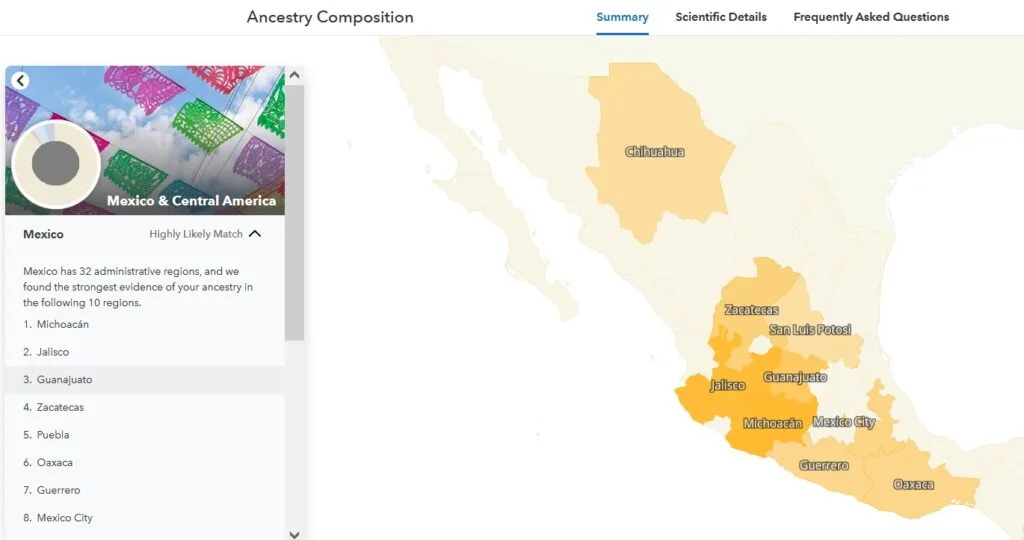
According to the map, the DNA tester also matches the states of Jalisco and Guanajuato, along with some other states.
The Recent Ancestry From the Americas feature on 23andMe results can help people discover to which group of the indigenous peoples of Mexico their ancestors may have belonged. For example, we know that the Purépecha people were located in what is now known as the Mexican state of Michoacán.
Does this mean that our DNA tester (my husband) has ancestors who were Purépecha? It is possible, but there were several other groups living in the region at the time, including the Nahua and the Matlatzinca.
Only family tree research can provide further evidence of someone's connection to a particular region. However, DNA testing can give important clues.
Important note: This post primarily addresses ethnicity results, or the ancestry report, which is essentially the colorful chart displaying the regions of the world that most closely match our DNA. However, 23andMe results include much more than just this report, such as 1500 genetic relatives on the DNA Relatives list.
23andMe results for someone born in Mexico
The 23andMe results of someone born in Mexico will vary based on their unique family history, of course. However, most people born in Mexico will likely find that they have some DNA the matching Indigenous Americas region, which spans both North and South America.
Other common ethnicity regions to show up on results for someone from Mexico might be Spanish and Portuguese, Ashkenazi Jewish, Ghanaian, Liberian & Sierra Leonean, Italian, British and Irish, Broadly Southern European, North African, Eastern European, or really any other region of the world.
Every Mexican family has its own unique history, and so the other way to discover what your DNA could reveal on 23andMe is to go ahead and take the test.
It is also possible for 23andMe results for people with substantial indigenous ancestry to show a category that is currently named "Broadly East Asian and Indigenous American", due to the ancient genetic connection between these two regions of the world.
As promised, below is an example of DNA results for my husband, who was born in a mountainous indigenous village in Mexico:
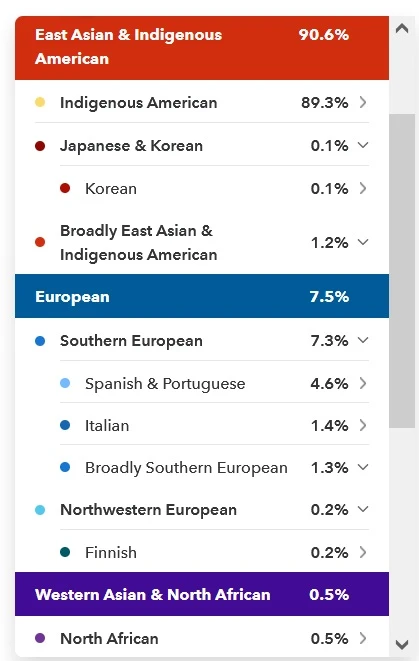
Most of his ancestors were Native American, including his recent ancestors who were speakers of Nahuatl, like he is, along with more than a million other people in Mexico and abroad. Since he was from an isolated mountain region, his village was difficult to reach until only the past few decades.
This might be an explanation as to why he has only small percentages of African, European, and Asian ancestry. People from other regions of Mexico might find that their results are similar, or vary greatly.
23andMe results with a parent born in Mexico
The results below belong to a person with a parent born in Tampaulipas, Mexico. However, our DNA tester's ancestors, Huastec speakers identifying as Huastec people (Huastecos in español), had previously migrated from the state of Veracruz to Tampaulipas in search of economic opportunities.
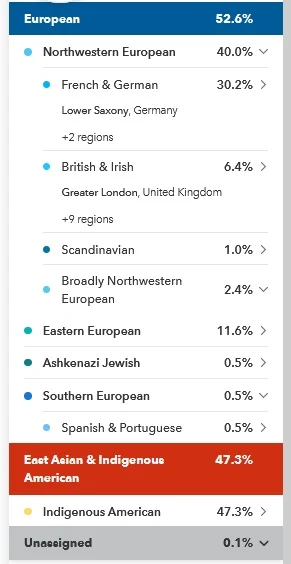
The DNA tester's other parent was born in the United States, and had ancestors from Northwestern and Eastern Europe.
They were curious as to why their parent's DNA did not seem to match the Recent Ancestry in the Americas countries. One possible explanation is that their ancestor's DNA matches a group of people whose descendants have not yet participated in DNA testing in great numbers.
Alternatively, it could mean that our DNA tester's Native American ancestors match multiple countries or regions, making it more difficult to distinguish more specific geographic locations with current DNA testing technologies. This theory could be tested with careful examination of their closer DNA matches.
The great thing about 23andMe results is that they are occasionally updated as new research is discovered and technology improves. For example, my husband's DNA results (in the first example above) did not initially show a match to Mexico, or any particular state within Mexico, but after an update there was a match.
Hopefully, our DNA tester can learn more from their results at some point in a future update of 23andMe results.
Conclusion
I hope that this post has helped you understand what you might be able to expect from your 23andMe results if you have recent ancestors from Mexico. Even more importantly, I hope that you are excited about discovering more about your Mexican heritage.
If you have any questions about something that you read in this post, or if you would like to share your own experience with exploring your roots in Mexico through DNA results, I would love for you to join in the discussion below.
Thanks for reading today!

V. Lopez
Thursday 21st of April 2022
Hi, I did both 23&me & Ancestory & you see a good bit of difference. I was hoping to find more about the Native American vs Mexican but it seems it's combined in both. I was going to post screenshots of both but I don't think this allows it.
Lau
Friday 24th of June 2022
@V. Lopez, I too am debating on whether to take the 23&me or AncestryDNa test. I am curious if you found one of them to be more accurate or more specific in regards to your Native American DNA. Was there a big difference in % when it came to that for both tests? Thanks for sharing!